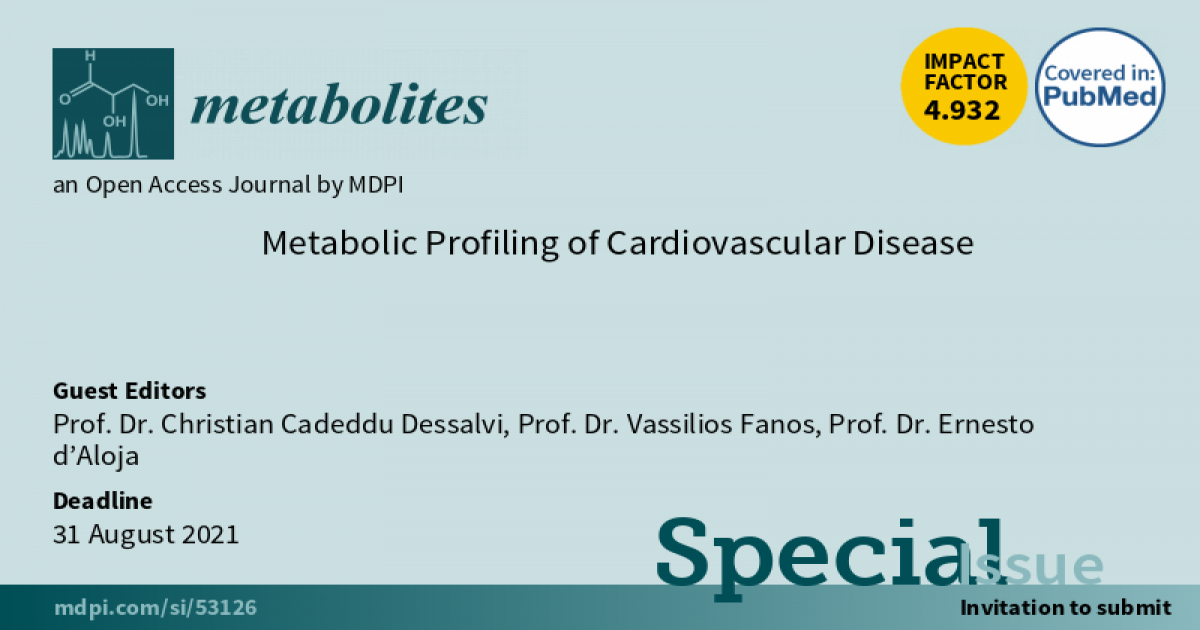Metabolic Profiling of Cardiovascular Disease
A special issue of Metabolites (ISSN 2218-1989). This special issue belongs to the section "Advances in Metabolomics".
Deadline for manuscript submissions: closed (31 August 2021) | Viewed by 57290

Special Issue Editors
Interests: cardiovascula disease; heart failure; cardiovascular metabolism; drug cardiotoxicity; non-invasive cardiovascular imaging
Special Issues, Collections and Topics in MDPI journals
Interests: neonatology; nephrology; pharmacology; infections; microbiomics; metabolomics
Special Issues, Collections and Topics in MDPI journals
Interests: autopsy; bioethics; forensic medicine; forensic pathology; DNA profiling
Special Issues, Collections and Topics in MDPI journals
Special Issue Information
Dear Colleagues,
The first cause of morbidity and mortality in industrialised countries is represented nowadays by cardiovascular diseases. During the last decade, both animal and human studies have facilitated the rapid development of metabolomics, and a combination of targeted and untargeted approaches has been applied for cardiovascular research. Specific metabolic profiles have been identified for several cardiovascular risk factors and diseases. In this Special Issue, our aim is to provide an in-depth view of metabolomics, addressing the current rationale for its application to cardiology and describing relevant data available from animal and human studies. This Special Issue show the importance of metabolomic application in understanding the mechanisms underlying diseases from a systems biology perspective and as a non-invasive approach to diagnosis, grading, and treatment of cardiovascular diseases.
Prof. Dr. Christian Cadeddu Dessalvi
Prof. Dr. Vassilios Fanos
Prof. Dr. Ernesto d’Aloja
Guest Editors
Manuscript Submission Information
Manuscripts should be submitted online at www.mdpi.com by registering and logging in to this website. Once you are registered, click here to go to the submission form. Manuscripts can be submitted until the deadline. All submissions that pass pre-check are peer-reviewed. Accepted papers will be published continuously in the journal (as soon as accepted) and will be listed together on the special issue website. Research articles, review articles as well as short communications are invited. For planned papers, a title and short abstract (about 100 words) can be sent to the Editorial Office for announcement on this website.
Submitted manuscripts should not have been published previously, nor be under consideration for publication elsewhere (except conference proceedings papers). All manuscripts are thoroughly refereed through a single-blind peer-review process. A guide for authors and other relevant information for submission of manuscripts is available on the Instructions for Authors page. Metabolites is an international peer-reviewed open access monthly journal published by MDPI.
Please visit the Instructions for Authors page before submitting a manuscript. The Article Processing Charge (APC) for publication in this open access journal is 2700 CHF (Swiss Francs). Submitted papers should be well formatted and use good English. Authors may use MDPI's English editing service prior to publication or during author revisions.
Keywords
- metabolomics
- cardiovascular diseases
- diagnosis
- personalized medicine
- biomarkers
- cardiac function
- cardiovascular metabolism
Benefits of Publishing in a Special Issue
- Ease of navigation: Grouping papers by topic helps scholars navigate broad scope journals more efficiently.
- Greater discoverability: Special Issues support the reach and impact of scientific research. Articles in Special Issues are more discoverable and cited more frequently.
- Expansion of research network: Special Issues facilitate connections among authors, fostering scientific collaborations.
- External promotion: Articles in Special Issues are often promoted through the journal's social media, increasing their visibility.
- Reprint: MDPI Books provides the opportunity to republish successful Special Issues in book format, both online and in print.
Further information on MDPI's Special Issue policies can be found here.








